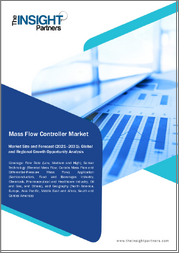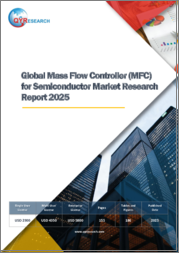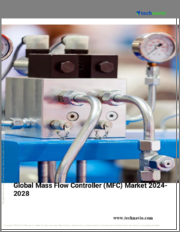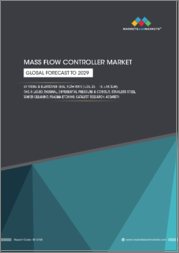
|
시장보고서
상품코드
1636735
매스 플로우 컨트롤러 시장 예측(-2030년) : 제품 유형, 매채 유형, 재료, 유량, 연결성, 용도, 최종 사용자, 지역별 세계 예측Mass Flow Controller Market Forecast to 2030 - Global Analysis By Product Type, Media Type, Material, Flow Rate, Connectivity, Application, End User and By Geography |
||||||
Stratistics MRC에 따르면 세계의 매스 플로우 컨트롤러 시장은 2024년에 16억 달러를 차지했습니다. 예측 기간 동안 CAGR 9.3%로 성장하며 2030년에는 27억 달러에 이를 전망입니다.
시스템 내의 가스 및 액체의 유량을 제어하고 측정하는 데 사용되는 정밀한 도구를 매스 플로우 컨트롤러(MFC)라고 합니다. MFC는 실시간 매스 플로우 측정에 따라 유량을 변경하여 안정적이고 정확한 유량을 유지합니다. 화학 처리, 제약, 반도체 제조와 같은 정확한 유량 제어가 공정의 정확성, 효율성 및 안전성을 유지하는 데 필수적인 분야에서는 MFC가 필수적입니다.
반도체 산업협회(SIA)에 따르면 세계 반도체 산업의 매출은 2022년 5,741억 달러에 달할 전망입니다.
반도체 제조 수요 증가
반도체 제조에서 매스 플로우 컨트롤러 수요 증가는 시장의 주요 촉진요인입니다. 이 컨트롤러는 화학 증착 및 에칭과 같은 공정 중에 정확한 가스 유량을 유지하는 데 중요합니다. IoT, AI, 5G 기술의 진보에 힘입어 전자 산업의 급속한 확대가 반도체에 대한 요구를 증폭하고, 매스 플로우 컨트롤러의 채용을 뒷받침하고 있습니다. 첨단 전자기기에 대한 의존도가 세계적으로 증가하고 있기 때문에 이러한 추세는 앞으로도 계속될 것으로 예상됩니다.
원재료 가격 변동
매스 플로우 컨트롤러의 제조에 사용되는 스테인레스 스틸 및 기타 금속과 같은 원재료 가격 변동은 큰 억제요인이되었습니다. 이러한 가격 변동은 특히 중소 업체의 제조 비용과 이익률에 영향을 미칩니다. 또한 공급망의 혼란과 지정학적 요인은 가격 변동을 더욱 악화시킵니다. 이러한 불확실성은 제조업체가 장기 투자 계획을 세우는 것을 어렵게 만들고 시장 성장을 방해합니다.
스마트 제조업의 상승
스마트 제조업의 상승은 매스 플로우 컨트롤러 시장에 큰 기회를 제공합니다. IoT 및 AI를 포함한 Industry 4.0 기술의 통합으로 매스 플로우 컨트롤러는 더욱 정교하고 실시간 모니터링 및 정확성 향상을 실현합니다. 이러한 기술 혁신은 정확성이 가장 중요하게 여겨지는 제약, 화학, 식품 가공과 같은 업계에서 특히 유용합니다. 산업 부문 전체에서 자동화와 디지털화의 도입이 진행됨에 따라 지능형 매스 플로우 컨트롤러 수요가 높아질 것으로 예상됩니다.
대체 기술의 가용성
체적 유량계와 같은 대체 기술의 가용성은 매스 플로우 컨트롤러 시장에 위협을 가하고 있습니다. 이러한 대체 기술은 비용이 적게 들고 단순한 디자인을 제공하며 비용에 민감한 구매자에게 매력적입니다. 게다가, 경쟁 기술의 진보는 특정 용도에서 매스 플로우 컨트롤러에 대한 의존도를 감소시킬 수 있습니다. 이러한 경쟁은 제조업체가 경쟁력을 유지하기 위한 기술 혁신을 수행하지 않는 한 시장 성장을 제한할 수 있습니다.
COVID-19의 영향 :
COVID-19의 대유행은 매스 플로우 컨트롤러 시장에 다양한 영향을 미쳤습니다. 처음에는 공급망의 혼란과 산업 활동의 감소가 성장을 방해했지만 생명 공학 및 제약과 같은 분야 수요 증가가 이러한 문제를 상쇄했습니다. 유행기간 동안 매스 플로우 컨트롤러는 백신 제조 및 의료기기 제조에 필수적이 되어 의료 관련 용도에서 중요한 역할을 부각시켰습니다.
예측 기간 동안 열식 매스 플로우 컨트롤러 부문이 최대가 될 것으로 예상
열식 매스 플로우 컨트롤러 부문은 반도체, 화학, 석유 및 가스 등의 산업에서 널리 채택되어 예측 기간 동안 최대 시장 점유율을 차지할 것으로 예상됩니다. 이러한 컨트롤러는 다양한 조건 하에서 가스 유량 측정에서 높은 정확도와 신뢰성을 제공합니다. 다양한 유형의 가스를 다룰 수 있기 때문에 반도체 제조 및 화학 처리와 같은 중요한 응용 분야에 필수적입니다.
예측기간 동안 생명공학 및 의약품 분야에서 CAGR이 가장 높아질 전망
예측 기간 동안 생명공학과 의약품 분야가 가장 높은 CAGR을 나타낼 것으로 예상됩니다. 의약품 개발, 백신 제조 및 바이오 의약품 연구에 대한 관심 증가는 매스 플로우 컨트롤러와 같은 정밀 유체 제어 시스템 수요를 촉진하고 있습니다. 이러한 장치는 제조 공정에서 정확한 투여와 혼합을 보장하며 의약품 제조에서 품질 기준을 유지하는 데 필수적입니다.
최대 점유율을 차지하는 지역 :
아시아태평양은 반도체 제조의 장점과 급속한 산업화로 예측 기간 동안 최대 시장 점유율을 차지할 것으로 예상됩니다. 중국, 일본, 한국, 대만과 같은 국가는 전자 생산의 주요 기지이며 매스 플로우 컨트롤러의 큰 수요를 견인하고 있습니다. 또한 이 지역의 제약산업 확대는 시장 리더십에 더욱 기여하고 있습니다.
CAGR이 가장 높은 지역 :
아시아태평양은 스마트 매뉴팩처링에 대한 투자 증가와 산업 전반의 기술 진보로 예측 기간 동안 가장 높은 성장률을 나타낼 것으로 예측됩니다. 인도나 동남아시아 국가 등 신흥경제권에서 자동화 도입이 진행되고 있는 것이 이 성장을 더욱 가속시키고 있습니다. 이 지역은 혁신에 중점을 두고 있기 때문에 고급 매스 플로우 컨트롤러 솔루션에 대한 수요가 지속됩니다.
무료 맞춤설정 제공 :
이 보고서를 구독하는 고객은 다음 무료 맞춤설정 옵션 중 하나를 사용할 수 있습니다.
- 기업 프로파일
- 추가 시장 기업의 종합적 프로파일링(3개사까지)
- 주요 기업의 SWOT 분석(3개사까지)
- 지역 세분화
- 고객의 관심에 응한 주요국 시장 추계·예측·CAGR(참고 : 타당성 확인에 따름)
- 경쟁 벤치마킹
- 제품 포트폴리오, 지리적 존재, 전략적 제휴에 기반한 주요 기업 벤치마킹
목차
제1장 주요 요약
제2장 서문
- 개요
- 이해관계자
- 조사 범위
- 조사 방법
- 데이터 마이닝
- 데이터 분석
- 데이터 검증
- 조사 접근
- 조사 정보원
- 1차 조사 정보원
- 2차 조사 정보원
- 전제조건
제3장 시장 동향 분석
- 성장 촉진요인
- 성장 억제요인
- 기회
- 위협
- 제품분석
- 용도 분석
- 최종 사용자 분석
- 신흥 시장
- COVID-19의 영향
제4장 Porter's Five Forces 분석
- 공급기업의 협상력
- 구매자의 협상력
- 대체품의 위협
- 신규 참가업체의 위협
- 경쟁 기업간 경쟁 관계
제5장 세계의 매스 플로우 컨트롤러 시장 : 제품 유형별
- 열식 매스 플로우 컨트롤러
- 차압 플로우 컨트롤러
- 코리올리 플로우 컨트롤러
제6장 세계의 매스 플로우 컨트롤러 시장 : 미디어 유형별
- 가스
- 공정 가스
- 특수 가스
- 산업용 가스
- 액체
- 초순수
- 화학 물질
- 냉각수
- 다상 유체
- 가스와 액체의 혼합물
- 슬러리
제7장 세계의 매스 플로우 컨트롤러 시장 : 재료별
- 스테인레스 스틸
- 특수 합금
- 하스테로이
- 모넬
- 인코넬
제8장 세계의 매스 플로우 컨트롤러 시장 : 유량별
- 저유량
- 중유량
- 고유량
제9장 세계의 매스 플로우 컨트롤러 시장 : 접속성별
- 아날로그
- 디지털 프로토콜
- 프로피버스
- 프로피넷
- RS-485
- 이더캣
- 모드 버스 RTU
- 디바이스 넷
- 모드 버스 TCPIP
- 파운데이션 필드버스
제10장 세계의 매스 플로우 컨트롤러 시장 : 용도별
- 반도체 제조
- 화학 기상 증착(CVD)
- 물리 기상 증착(PVD)
- 플라즈마 에칭
- 분석기기
- 가스 크로마토그래피
- 질량 분석
- 공정 제어
- 촉매 연구
- 가스 혼합 및 블렌드
- 표면 처리
- 열 관리 시스템
제11장 세계의 매스 플로우 컨트롤러 시장 : 최종 사용자별
- 반도체 산업
- 화학처리
- 석유 및 가스
- 제약·바이오테크놀러지
- 야금 및 광업
- 음식
- 물 및 폐수 처리
제12장 세계의 매스 플로우 컨트롤러 시장 : 지역별
- 북미
- 미국
- 캐나다
- 멕시코
- 유럽
- 독일
- 영국
- 이탈리아
- 프랑스
- 스페인
- 기타 유럽
- 아시아태평양
- 일본
- 중국
- 인도
- 호주
- 뉴질랜드
- 한국
- 기타 아시아태평양
- 남미
- 아르헨티나
- 브라질
- 칠레
- 기타 남미
- 중동 및 아프리카
- 사우디아라비아
- 아랍에미리트(UAE)
- 카타르
- 남아프리카
- 기타 중동 및 아프리카
제13장 주요 발전
- 계약/파트너십/협업/합작투자(JV)
- 인수와 합병
- 신제품 발매
- 사업 확대
- 기타 주요 전략
제14장 기업 프로파일링
- HORIBA Ltd.
- Sensirion AG
- MKS Instruments
- Teledyne Technologies
- Bronkhorst High-Tech
- Brooks Instrument
- Burkert Fluid Control Systems
- Sierra Instruments
- Alicat Scientific
- Parker Hannifin Corporation
- Tokyo Keiso Co.
- Vogtlin Instruments
- Azbil Corporation
- Axetris AG
- Aalborg
- ICES Solutions
According to Stratistics MRC, the Global Mass Flow Controller Market is accounted for $1.6 billion in 2024 and is expected to reach $2.7 billion by 2030 growing at a CAGR of 9.3% during the forecast period. The precise tool used to control and measure the flow of gases or liquids in a system is called a mass flow controller (MFC). It maintains steady and precise flow rates by modifying the flow in response to real-time mass flow measurements. In sectors where exact flow control is vital for preserving process accuracy, efficiency, and safety, such as chemical processing, pharmaceuticals, and semiconductor manufacturing, MFCs are indispensable.
According to the Semiconductor Industry Association (SIA), global semiconductor industry sales reached $574.1 billion in 2022.
Market Dynamics:
Driver:
Growing demand in semiconductor manufacturing
The increasing demand for mass flow controllers in semiconductor manufacturing is a key driver for the market. These controllers are critical in maintaining precise gas flow rates during processes like chemical vapor deposition and etching. The rapid expansion of the electronics industry, fueled by advancements in IoT, AI, and 5G technologies, has amplified the need for semiconductors, thereby boosting the adoption of mass flow controllers. This trend is expected to persist as the global reliance on advanced electronic devices continues to grow.
Restraint:
Volatility in raw material prices
The fluctuating prices of raw materials such as stainless steel and other metals used in manufacturing mass flow controllers act as a significant restraint. These price variations impact production costs and profit margins, especially for small and medium-sized manufacturers. Additionally, supply chain disruptions and geopolitical factors further exacerbate price volatility. Such uncertainties make it challenging for manufacturers to plan long-term investments, thereby hindering market growth.
Opportunity:
Emergence of smart manufacturing
The rise of smart manufacturing presents a significant opportunity for the mass flow controller market. With the integration of Industry 4.0 technologies, including IoT and AI, mass flow controllers are becoming more advanced, offering real-time monitoring and enhanced precision. These innovations are particularly beneficial in industries like pharmaceuticals, chemicals, and food processing, where accuracy is paramount. The growing adoption of automation and digitalization across industrial sectors is expected to drive demand for intelligent mass flow controllers.
Threat:
Availability of alternatives
The availability of alternative technologies such as volumetric flow meters poses a threat to the mass flow controller market. These alternatives often offer lower costs and simpler designs, making them attractive to cost-sensitive buyers. Additionally, advancements in competing technologies could reduce the reliance on mass flow controllers in certain applications. This competition may limit market growth unless manufacturers innovate to maintain their competitive edge.
Covid-19 Impact:
The COVID-19 pandemic had a mixed impact on the mass flow controller market. While disruptions in supply chains and reduced industrial activities initially hampered growth, the increased demand from sectors like biotechnology and pharmaceuticals offset these challenges. Mass flow controllers became essential in vaccine production and medical device manufacturing during the pandemic, highlighting their critical role in healthcare-related applications.
The thermal mass flow controllers segment is expected to be the largest during the forecast period
The thermal mass flow controllers segment is expected to account for the largest market share during the forecast period due to their widespread adoption across industries like semiconductors, chemicals, and oil & gas. These controllers offer high accuracy and reliability in measuring gas flow rates under varying conditions. Their ability to handle a wide range of gases makes them indispensable in critical applications such as semiconductor fabrication and chemical processing.
The biotechnology and pharmaceuticals segment is expected to have the highest CAGR during the forecast period
Over the forecast period, the biotechnology and pharmaceuticals segment is expected to witness the highest CAGR. The growing focus on drug development, vaccine production, and biopharmaceutical research drives demand for precise fluid control systems like mass flow controllers. These devices ensure accurate dosing and mixing during production processes, making them integral to maintaining quality standards in pharmaceutical manufacturing.
Region with largest share:
The Asia Pacific region is anticipated to account for the largest market share during the forecast period due to its dominance in semiconductor manufacturing and rapid industrialization. Countries like China, Japan, South Korea, and Taiwan are major hubs for electronics production, driving significant demand for mass flow controllers. Additionally, expanding pharmaceutical industries in this region further contribute to its market leadership.
Region with highest CAGR:
The Asia Pacific region is anticipated to register the highest growth rate over the forecast period owing to increasing investments in smart manufacturing and technological advancements across industries. The growing adoption of automation in emerging economies like India and Southeast Asian countries further accelerates this growth. The region's focus on innovation ensures sustained demand for advanced mass flow controller solutions.
Key players in the market
Some of the key players in Mass Flow Controller Market include HORIBA Ltd., Sensirion AG, MKS Instruments, Teledyne Technologies, Bronkhorst High-Tech, Brooks Instrument, Burkert Fluid Control Systems, Sierra Instruments, Alicat Scientific, Parker Hannifin Corporation, Tokyo Keiso Co., Vogtlin Instruments, Azbil Corporation, Axetris AG, Aalborg and ICES Solutions.
Key Developments:
In March 2024, Brooks Instrument has released its new GF120xHT series high-temperature of thermal mass flow controllers. This is the company's first high-temperature mass flow controller in the GF family and is specifically designed to support precursors required in semiconductor manufacturing including liquid precursors for compound semiconductors.
In November 2019, HORIBA, Ltd. will be launching the DZ-100 ultra-thin Mass Flow Controller (MFC) this spring. The DZ-100 controller is counted as one of the MFCs that the HORIBA Group has developed itself. The ultra-thin MFC DZ-100 inherits the high sensitivity and broad range of flow control technology used in HORIBA STEC's mainstream product, the pressure-insensitive MFC D500, yet has its module width reduced from 28.575 mm (1.125 inches) to 10 mm, roughly a third of the existing width, without performance loss due to size reduction, and weighs 70% less at 230g.
Product Types Covered:
- Thermal Mass Flow Controllers
- Differential Pressure Flow Controllers
- Coriolis Flow Controllers
Media Types Covered:
- Gas
- Liquid
- Multi-phase Fluids
Materials Covered:
- Stainless Steel
- Exotic Alloys
Flow Rates Covered:
- Low Flow
- Medium Flow
- High Flow
Connectivity's Covered:
- Analog
- Digital Protocols
Applications Covered:
- Semiconductor Fabrication
- Analytical Instrumentation
- Process Control
- Surface Treatment
- Thermal Management Systems
End Users Covered:
- Semiconductor Industry
- Chemical Processing
- Oil & Gas
- Pharmaceutical & Biotechnology
- Metallurgy & Mining
- Food & Beverage
- Water & Wastewater Treatment
Regions Covered:
- North America
- US
- Canada
- Mexico
- Europe
- Germany
- UK
- Italy
- France
- Spain
- Rest of Europe
- Asia Pacific
- Japan
- China
- India
- Australia
- New Zealand
- South Korea
- Rest of Asia Pacific
- South America
- Argentina
- Brazil
- Chile
- Rest of South America
- Middle East & Africa
- Saudi Arabia
- UAE
- Qatar
- South Africa
- Rest of Middle East & Africa
What our report offers:
- Market share assessments for the regional and country-level segments
- Strategic recommendations for the new entrants
- Covers Market data for the years 2022, 2023, 2024, 2026, and 2030
- Market Trends (Drivers, Constraints, Opportunities, Threats, Challenges, Investment Opportunities, and recommendations)
- Strategic recommendations in key business segments based on the market estimations
- Competitive landscaping mapping the key common trends
- Company profiling with detailed strategies, financials, and recent developments
- Supply chain trends mapping the latest technological advancements
Free Customization Offerings:
All the customers of this report will be entitled to receive one of the following free customization options:
- Company Profiling
- Comprehensive profiling of additional market players (up to 3)
- SWOT Analysis of key players (up to 3)
- Regional Segmentation
- Market estimations, Forecasts and CAGR of any prominent country as per the client's interest (Note: Depends on feasibility check)
- Competitive Benchmarking
- Benchmarking of key players based on product portfolio, geographical presence, and strategic alliances
Table of Contents
1 Executive Summary
2 Preface
- 2.1 Abstract
- 2.2 Stake Holders
- 2.3 Research Scope
- 2.4 Research Methodology
- 2.4.1 Data Mining
- 2.4.2 Data Analysis
- 2.4.3 Data Validation
- 2.4.4 Research Approach
- 2.5 Research Sources
- 2.5.1 Primary Research Sources
- 2.5.2 Secondary Research Sources
- 2.5.3 Assumptions
3 Market Trend Analysis
- 3.1 Introduction
- 3.2 Drivers
- 3.3 Restraints
- 3.4 Opportunities
- 3.5 Threats
- 3.6 Product Analysis
- 3.7 Application Analysis
- 3.8 End User Analysis
- 3.9 Emerging Markets
- 3.10 Impact of Covid-19
4 Porters Five Force Analysis
- 4.1 Bargaining power of suppliers
- 4.2 Bargaining power of buyers
- 4.3 Threat of substitutes
- 4.4 Threat of new entrants
- 4.5 Competitive rivalry
5 Global Mass Flow Controller Market, By Product Type
- 5.1 Introduction
- 5.2 Thermal Mass Flow Controllers
- 5.3 Differential Pressure Flow Controllers
- 5.4 Coriolis Flow Controllers
6 Global Mass Flow Controller Market, By Media Type
- 6.1 Introduction
- 6.2 Gas
- 6.2.1 Process Gases
- 6.2.2 Specialty Gases
- 6.2.3 Industrial Gases
- 6.3 Liquid
- 6.3.1 Ultra-pure Water
- 6.3.2 Chemicals
- 6.3.3 Coolants
- 6.4 Multi-phase Fluids
- 6.4.1 Gas-liquid Mixtures
- 6.4.2 Slurries
7 Global Mass Flow Controller Market, By Material
- 7.1 Introduction
- 7.2 Stainless Steel
- 7.3 Exotic Alloys
- 7.3.1 Hastelloy
- 7.3.2 Monel
- 7.3.3 Inconel
8 Global Mass Flow Controller Market, By Flow Rate
- 8.1 Introduction
- 8.2 Low Flow
- 8.3 Medium Flow
- 8.4 High Flow
9 Global Mass Flow Controller Market, By Connectivity
- 9.1 Introduction
- 9.2 Analog
- 9.3 Digital Protocols
- 9.3.1 Profibus
- 9.3.2 Profinet
- 9.3.3 RS-485
- 9.3.4 Ethercat
- 9.3.5 Modbus RTU
- 9.3.6 Device Net
- 9.3.7 Modbus TCPIP
- 9.3.8 Foundation Fieldbus
10 Global Mass Flow Controller Market, By Application
- 10.1 Introduction
- 10.2 Semiconductor Fabrication
- 10.2.1 Chemical Vapor Deposition (CVD)
- 10.2.2 Physical Vapor Deposition (PVD)
- 10.2.3 Plasma Etching
- 10.3 Analytical Instrumentation
- 10.3.1 Gas Chromatography
- 10.3.2 Mass Spectrometry
- 10.4 Process Control
- 10.4.1 Catalyst Research
- 10.4.2 Gas Mixing & Blending
- 10.5 Surface Treatment
- 10.6 Thermal Management Systems
11 Global Mass Flow Controller Market, By End User
- 11.1 Introduction
- 11.2 Semiconductor Industry
- 11.3 Chemical Processing
- 11.4 Oil & Gas
- 11.5 Pharmaceutical & Biotechnology
- 11.6 Metallurgy & Mining
- 11.7 Food & Beverage
- 11.8 Water & Wastewater Treatment
12 Global Mass Flow Controller Market, By Geography
- 12.1 Introduction
- 12.2 North America
- 12.2.1 US
- 12.2.2 Canada
- 12.2.3 Mexico
- 12.3 Europe
- 12.3.1 Germany
- 12.3.2 UK
- 12.3.3 Italy
- 12.3.4 France
- 12.3.5 Spain
- 12.3.6 Rest of Europe
- 12.4 Asia Pacific
- 12.4.1 Japan
- 12.4.2 China
- 12.4.3 India
- 12.4.4 Australia
- 12.4.5 New Zealand
- 12.4.6 South Korea
- 12.4.7 Rest of Asia Pacific
- 12.5 South America
- 12.5.1 Argentina
- 12.5.2 Brazil
- 12.5.3 Chile
- 12.5.4 Rest of South America
- 12.6 Middle East & Africa
- 12.6.1 Saudi Arabia
- 12.6.2 UAE
- 12.6.3 Qatar
- 12.6.4 South Africa
- 12.6.5 Rest of Middle East & Africa
13 Key Developments
- 13.1 Agreements, Partnerships, Collaborations and Joint Ventures
- 13.2 Acquisitions & Mergers
- 13.3 New Product Launch
- 13.4 Expansions
- 13.5 Other Key Strategies
14 Company Profiling
- 14.1 HORIBA Ltd.
- 14.2 Sensirion AG
- 14.3 MKS Instruments
- 14.4 Teledyne Technologies
- 14.5 Bronkhorst High-Tech
- 14.6 Brooks Instrument
- 14.7 Burkert Fluid Control Systems
- 14.8 Sierra Instruments
- 14.9 Alicat Scientific
- 14.10 Parker Hannifin Corporation
- 14.11 Tokyo Keiso Co.
- 14.12 Vogtlin Instruments
- 14.13 Azbil Corporation
- 14.14 Axetris AG
- 14.15 Aalborg
- 14.16 ICES Solutions



















